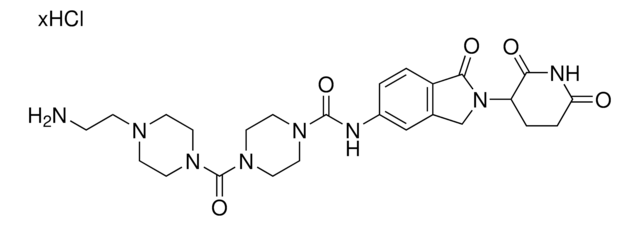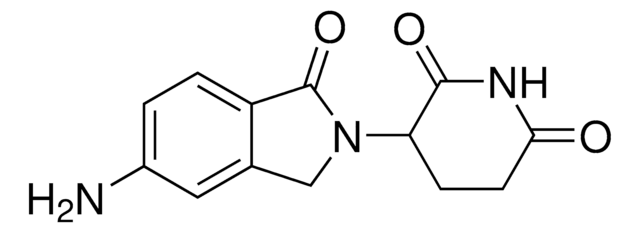921300
C5 Lenalidomide-pyrimidine-piperazine-PEG1-NH2 hydrochloride
≥95%
Synonyme(s) :
5-(4-(2-(2-Aminoethoxy)ethyl)piperazin-1-yl)-N-(2-(2,6-dioxopiperidin-3-yl)-1-oxoisoindolin-5-yl)pyrimidine-2-carboxamide hydrochloride, Crosslinker−E3 Ligase ligand conjugate, Protein degrader building block for PROTAC® research, Template for synthesis of targeted protein degrader
About This Item
Produits recommandés
ligand
C5 Lenalidomide
Niveau de qualité
Essai
≥95%
Forme
(Powder or crystals or flakes or chunks)
Pertinence de la réaction
reactivity: carboxyl reactive
reagent type: ligand-linker conjugate
Groupe fonctionnel
amine
Température de stockage
2-8°C
Chaîne SMILES
O=C1N(C2CCC(NC2=O)=O)CC3=CC(NC(C4=NC=C(N5CCN(CCOCCN)CC5)C=N4)=O)=CC=C31.Cl
InChI
1S/C26H32N8O5.ClH/c27-5-11-39-12-10-32-6-8-33(9-7-32)19-14-28-23(29-15-19)25(37)30-18-1-2-20-17(13-18)16-34(26(20)38)21-3-4-22(35)31-24(21)36;/h1-2,13-15,21H,3-12,16,27H2,(H,30,37)(H,31,35,36);1H
Clé InChI
VEHCGTYYGZOLLK-UHFFFAOYSA-N
Catégories apparentées
Application
Autres remarques
Portal: Building PROTAC® Degraders for Targeted Protein Degradation
Targeted Protein Degradation by Small Molecules
Small-Molecule PROTACS: New Approaches to Protein Degradation
Targeted Protein Degradation: from Chemical Biology to Drug Discovery
Impact of linker length on the activity of PROTACs
Informations légales
Produit(s) apparenté(s)
Code de la classe de stockage
11 - Combustible Solids
Classe de danger pour l'eau (WGK)
WGK 3
Point d'éclair (°F)
Not applicable
Point d'éclair (°C)
Not applicable
Faites votre choix parmi les versions les plus récentes :
Certificats d'analyse (COA)
It looks like we've run into a problem, but you can still download Certificates of Analysis from our Documents section.
Si vous avez besoin d'assistance, veuillez contacter Service Clients
Déjà en possession de ce produit ?
Retrouvez la documentation relative aux produits que vous avez récemment achetés dans la Bibliothèque de documents.
Global Trade Item Number
| Référence | GTIN |
|---|---|
| 921300-50MG | 4065266431766 |
Notre équipe de scientifiques dispose d'une expérience dans tous les secteurs de la recherche, notamment en sciences de la vie, science des matériaux, synthèse chimique, chromatographie, analyse et dans de nombreux autres domaines..
Contacter notre Service technique








